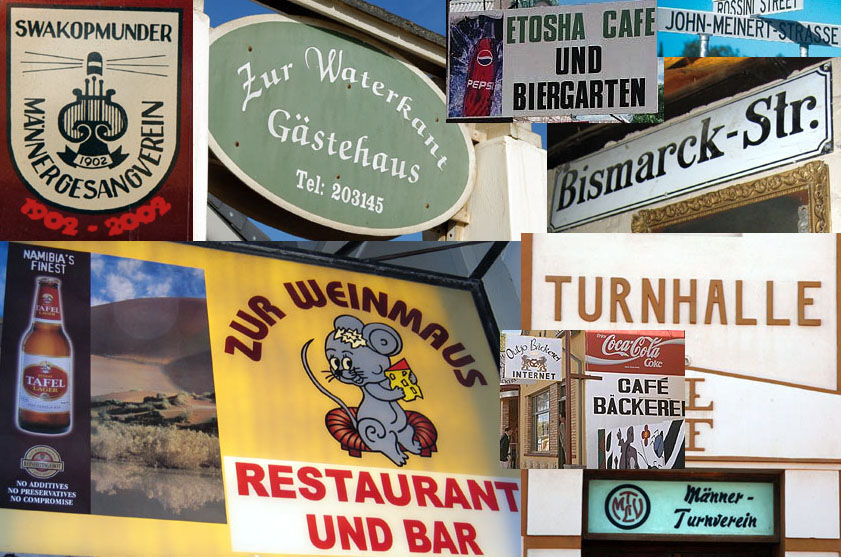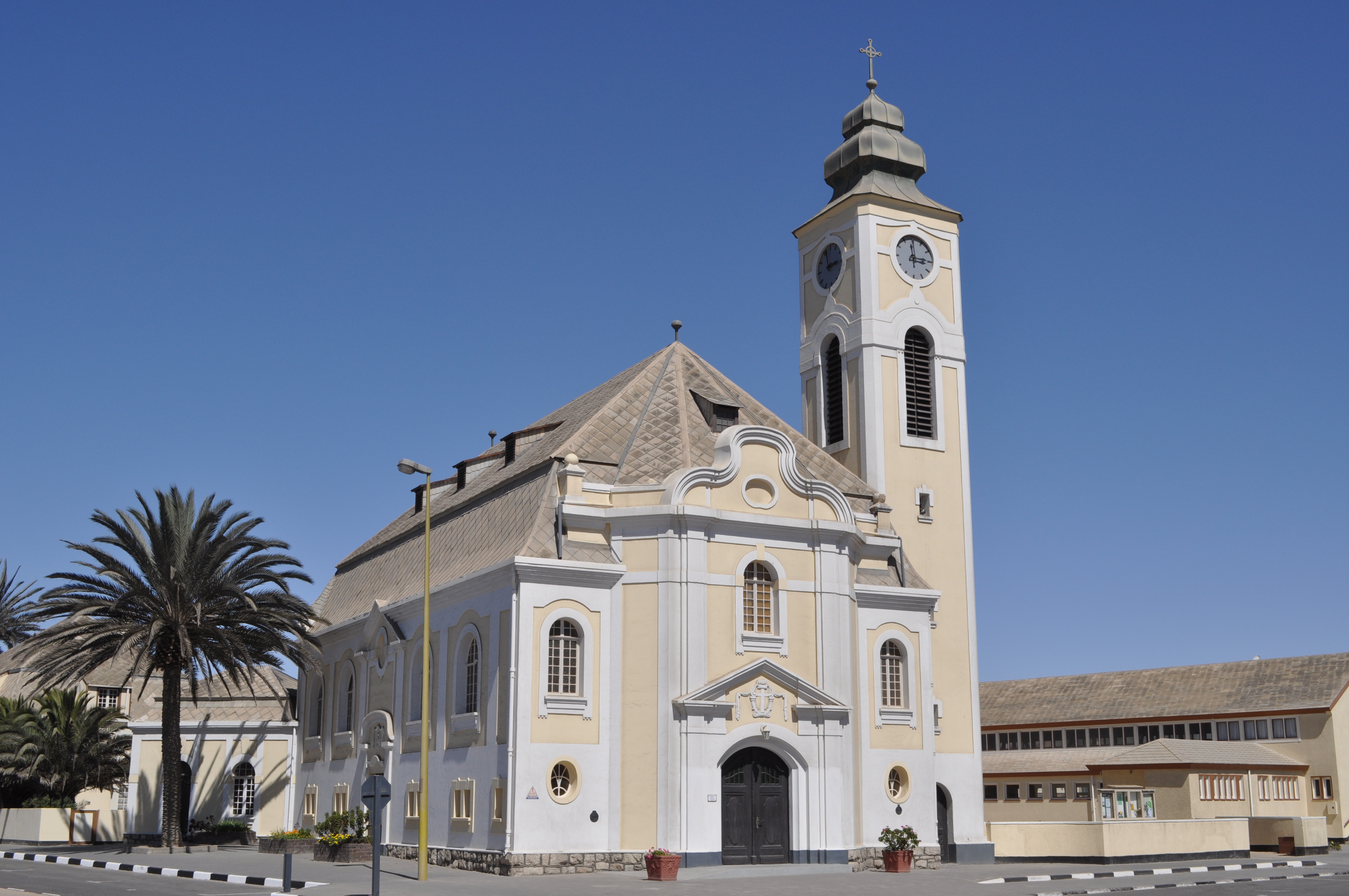|
German Language In Namibia
Namibia is a multilingual country wherein German is recognised as a national language (a form of minority language). While English has been the sole official language of the country since 1990, in many areas of the country, German enjoys official status at a community level. German, a Germanic language, is especially widely used in central and southern Namibia and was until 1990 one of three official languages in what was then South West Africa, alongside Afrikaans and English, two other Germanic languages in Namibia. German is the main or mother tongue of about 30,000 Namibians, a number composed roughly equally of German Namibians as well as older black speakers of Namibian Black German and Namibians who as children grew up in the German Democratic Republic (East Germany). The German Namibian newspaper '' Allgemeine Zeitung'' on its website refers to 22,000 native speakers and of several hundred thousand who know German as a second or third language. German benefits from its ... [...More Info...] [...Related Items...] OR: [Wikipedia] [Google] [Baidu] |
Namibia
Namibia (, ), officially the Republic of Namibia, is a country in Southern Africa. Its western border is the Atlantic Ocean. It shares land borders with Zambia and Angola to the north, Botswana to the east and South Africa to the south and east. Although Kazungula, it does not border Zimbabwe, less than 200 metres (660 feet) of the Botswanan right bank of the Zambezi, Zambezi River separates the two countries. Namibia gained independence from South Africa on 21 March 1990, following the Namibian War of Independence. Its capital and largest city is Windhoek. Namibia is a member state of the United Nations (UN), the Southern African Development Community (SADC), the African Union (AU) and the Commonwealth of Nations. The driest country in sub-Saharan Africa, Namibia has been inhabited since pre-historic times by the San people, San, Damara people, Damara and Nama people. Around the 14th century, immigration, immigrating Bantu peoples arrived as part of the Bantu expansion. Since ... [...More Info...] [...Related Items...] OR: [Wikipedia] [Google] [Baidu] |
Otjiwarongo
Otjiwarongo ( hz, beautiful place) is a city of 28,000 inhabitants in the Otjozondjupa Region of Namibia. It is the district capital of the Otjiwarongo electoral constituency and also the capital of Otjozondjupa. Otjiwarongo is situated in central-north Namibia on the TransNamib railway. It is the biggest business centre for Otjozondjupa Region. Otjiwarongo is located on the B1 road and its links between Windhoek, the Golden Triangle of Otavi, Tsumeb and Grootfontein, and Etosha National Park. It is one of Namibia's fast-growing towns, with a neat and peaceful quality environment and many excellent facilities, including supermarkets, banks, lodges, and hotels. Some of Namibia's best-known private game farms and nature reserves are located in and around the town. Otjiwarongo is one of Namibia's towns with a large population of German-speaking people. German influence is also evident in its Germanic buildings. The school "Donatus School Otjiwarongo" (D.S.O.) was once known ... [...More Info...] [...Related Items...] OR: [Wikipedia] [Google] [Baidu] |
Omaruru, Namibia
Omaruru is a city in the Erongo Region of central Namibia. The town has 14,000 inhabitants and owns of land. It is situated near Mount Erongo, on the usually dry Omaruru River. It is located on the main paved road from Swakopmund to Otjiwarongo. The name in the Otjiherero language means 'bitter milk', as Herero cattle herds used to graze on a local bush that turned their milk bitter. Omaruru is known for its annual festival where the Herero people commemorate their past local chiefs, its winery, and for the dinosaur footprints at nearby Otjihaenamparero. History Omaruru was established in 1863 by Wilhelm Zeraua, the first chief of the ''White Flag'' clan of the OvaHerero people. In 1871, Anders Ohlsson and Axel Eriksson established a brewery at Omaruru. Eriksson had also established a trading post, which flourished and by 1878 he employed about forty whites. Eriksson's business was based upon long-distance trading between southern Angola and Cape Colony, which necessitated ... [...More Info...] [...Related Items...] OR: [Wikipedia] [Google] [Baidu] |
EES (rapper)
Eric Sell, better known as EES (also: eesy-ees/EeS/EeS, "Easy Eric Sell"), is a German Namibian Kwaito artist and rapper. Sell was born in Windhoek on 5 October 1983. He lives both in Windhoek, Namibia's capital, and Cologne, Germany. His texts are written in a mixture of Afrikaans Afrikaans (, ) is a West Germanic language that evolved in the Dutch Cape Colony from the Dutch vernacular of Holland proper (i.e., the Hollandic dialect) used by Dutch, French, and German settlers and their enslaved people. Afrikaans gra ... and English. He also makes frequent use of Namlish and Namibian German (''Südwesterdeutsch''), the German dialect spoken in Namibia, and he popularised the term ''Nam-Slang'' for it. Awards Won *2008 Sanlam NBC Music Awards: Best Rock/Alternative Artist *2009 MTV Africa Music Awards: Listener Choice Award *2009 Namibian Music Awards: Artist of the Year *2011 Namibian Annual Music Awards: Best international achievement *2012 Namibian Annual Musi ... [...More Info...] [...Related Items...] OR: [Wikipedia] [Google] [Baidu] |
Hitradio Namibia
Hitradio Namibia is the first and only German language private radio station in Namibia. The station went on air on August 1, 2012. Owners were the German Namibians Wilfried Hähner and Sybille Rothkegel, accessed on May 15, 2013 and since October 2020 Sybille Moldzio, Björn Eichhoff and Kai-Uwe Schonecke. The station was from 2012 to 2014 and is since February 2020 located at in Windhoek. In between, Hitradio Namibia broadcast from its own broadcasting centre in Wind ... [...More Info...] [...Related Items...] OR: [Wikipedia] [Google] [Baidu] |
Giselher W
Giselher, Gisilher, Gisiler, or Giseler ( la, Gislaharius) is a Germanic masculine given name. It may refer to: *Giselher of Burgundy, Burgundian king * Gisilher (archbishop of Magdeburg), German ecclesiastic *Giselher Klebe (1925–2009), German composer *Giselher Wilke (1922–2007), German army officer See also *Gislhere __NOTOC__ Gislhere (died 785) was an English Bishop of Selsey in the eighth century. In 780 Gislhere witnessed a charter of Ealdorman Oslac of Sussex. Gislhere was present at the Synod of Brentford, Middlesex Middlesex (; abbreviation ... (died circa 785), English Bishop of Selsey {{given name German masculine given names ... [...More Info...] [...Related Items...] OR: [Wikipedia] [Google] [Baidu] |
Deutsche Höhere Privatschule Windhoek
The ''Deutsche Höhere Privatschule'' (DHPS) is a bilingual private school in Namibia. Situated in the capital Windhoek, The DHPS also offers boarding school facilities, a kindergarten and pre-school and primary and secondary grades from Grade 1 to grade 12. Various sporting facilities are part of the spacious campus in the centre of town, e.g. swimming pool, hostel, basketball courts, soccer fields, beach volleyball field and roller hockey rink. Scholars have the option of leaving with thNSSC(the Namibian Senior Secondary Certificate) in grade 12, which exempts them for Southern African universities and other Southern African institutions, or doing the (DIAP, The German International Abitur Examination), also in grade 12. History The school was established in 1909 under the name Kaiserliche Realschule (Imperial High School). Its name changed to Deutsche Höhere Privatschule ( en, German Private Higher School) upon the abdication of the German emperor Wilhelm II. The school c ... [...More Info...] [...Related Items...] OR: [Wikipedia] [Google] [Baidu] |
Evangelical Lutheran Church In Namibia (GELK)
The German-speaking Evangelical Lutheran Church in Namibia (known as GELC, GELK, or DELK) is a Lutheran denomination based in Namibia. It was founded in 1960, and has 4,434 members. GELC joined the Lutheran World Federation in 1963. It is also a member of the Council of Churches in Namibia. Along with the Evangelical Lutheran Church in Namibia and the Evangelical Lutheran Church in the Republic of Namibia, GELC formed the United Church Council of the Lutheran Churches in Namibia in 2007. The aim of this body is ultimately to achieve church union Church union is the name given to a merger of two or more Christian denominations. Such unions may take on many forms, including a united church and a federation. United churches {{main, United and uniting churches A united church is the res .... References External links * {{Namibia-stub 1960 establishments in South West Africa German-Namibian culture Lutheran denominations established in the 20th century Lutheran ... [...More Info...] [...Related Items...] OR: [Wikipedia] [Google] [Baidu] |
Namibian Broadcasting Corporation
The Namibian Broadcasting Corporation (NBC) ( af, Namibiese Uitsaai-Korporasie, ''NUK'') is the public broadcaster of Namibia. It was established in 1979, under the name South West African Broadcasting Corporation (SWABC). History Radio was originally broadcast in English and Afrikaans via shortwave from the South African Broadcasting Corporation's facilities in South Africa. The SABC introduced FM services in November 1969, relaying Radio South Africa, Radio Suid-Afrika and Springbok Radio, and establishing a number of services in native languages, including Radio Ovambo, broadcasting in the Kwanyama and Ndonga languages, Radio Herero and Radio Damara Nama. The introduction of Radio Kavango along the northeastern border with Angola followed in February 1976 in the Kwangali, Mbukushu and Gciriku languages. In 1965, the pro-independence movement, the South West Africa People's Organisation (SWAPO), began broadcasting a one-hour radio programme from Tanzania on short wave kn ... [...More Info...] [...Related Items...] OR: [Wikipedia] [Google] [Baidu] |
Basters
The Basters (also known as Baasters, Rehobothers or Rehoboth Basters) are a Southern African ethnic group descended from white European men and black African women, usually of Khoisan origin, but occasionally also enslaved women from the Cape, who resided in the Dutch Cape Colony in the 18th century. Since the second half of the 19th century, the Rehoboth Baster community has been concentrated in central Namibia, in and around the town of Rehoboth. Basters are closely related to Afrikaners, Cape Coloured and Griqua peoples of South Africa, with whom they share a language and culture. Other people of similar ethnic origin, living chiefly in the Northern Cape, also call themselves Basters. The name ''Baster'' is derived from "bastaard", the Dutch word for bastard (or "crossbreed"). While some people consider this term demeaning, the Basters reappropriated it as a "proud name", claiming their ancestry and history, treating it as a cultural category in spite of the negative co ... [...More Info...] [...Related Items...] OR: [Wikipedia] [Google] [Baidu] |
Rehoboth, Namibia
Rehoboth is a town in central Namibia just north of the Tropic of Capricorn. Located 90 kilometres (55 miles) south of the Namibian capital Windhoek, Rehoboth lies on a high elevation plateau with several natural hot-water springs. It receives sparse mean annual rainfall of , although in the 2010/2011 rainy season a record were measured. In 2005, it had a population of 21,378 later increased to 28,843 in 2011, according to the 2011 Namibian Population and Housing Census. Rehoboth is intersected from north to south by the national road B1, which also serves as the border of the two electoral constituencies in the town, Rehoboth Urban West and Rehoboth Urban East. Rehoboth is the core territory of the Baster community which still lives according to their ''Paternal Laws'' which were enacted in 1872. Administration Rehoboth is divided into eight neighbourhoods, called blocks. The oldest part of the town is blocks A, B and C, of which block B contains most public services and ... [...More Info...] [...Related Items...] OR: [Wikipedia] [Google] [Baidu] |




